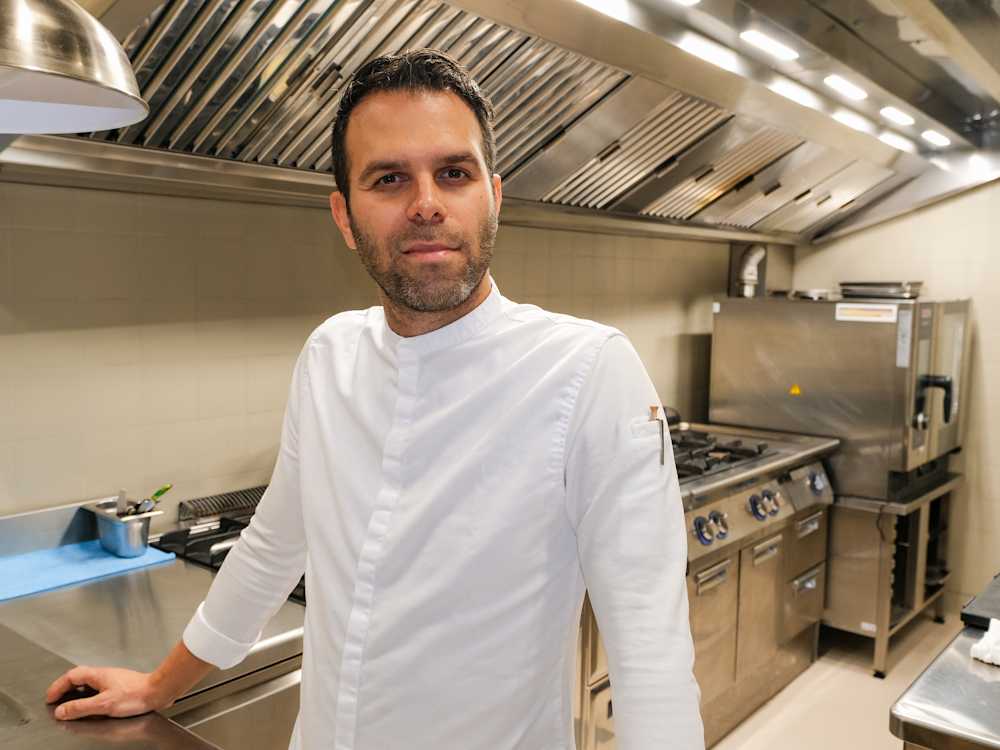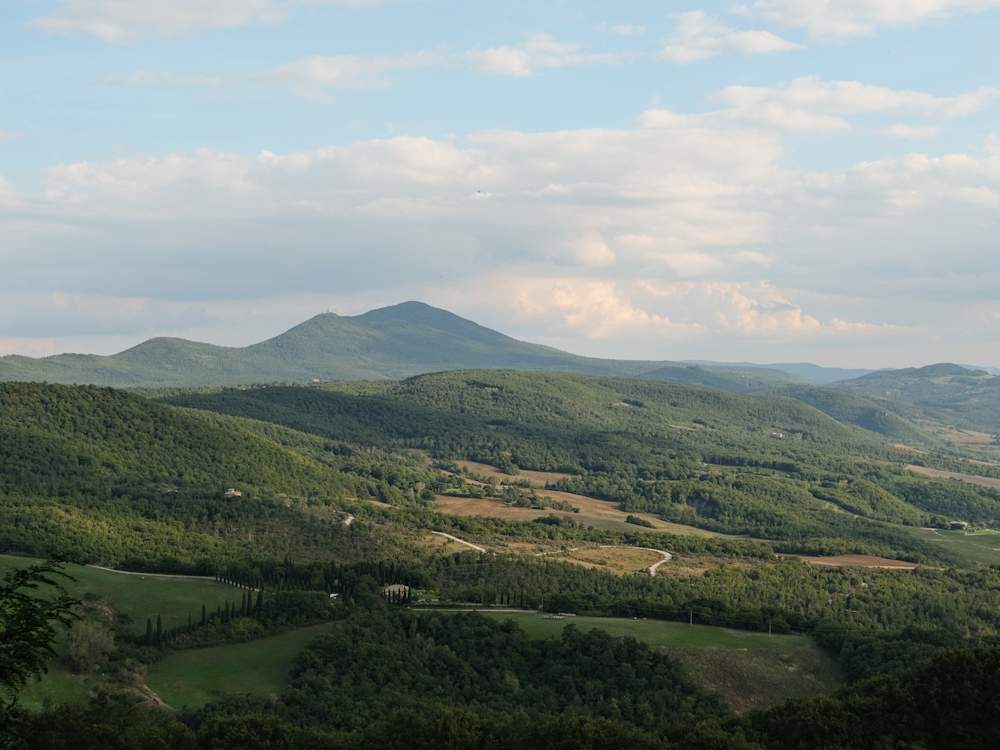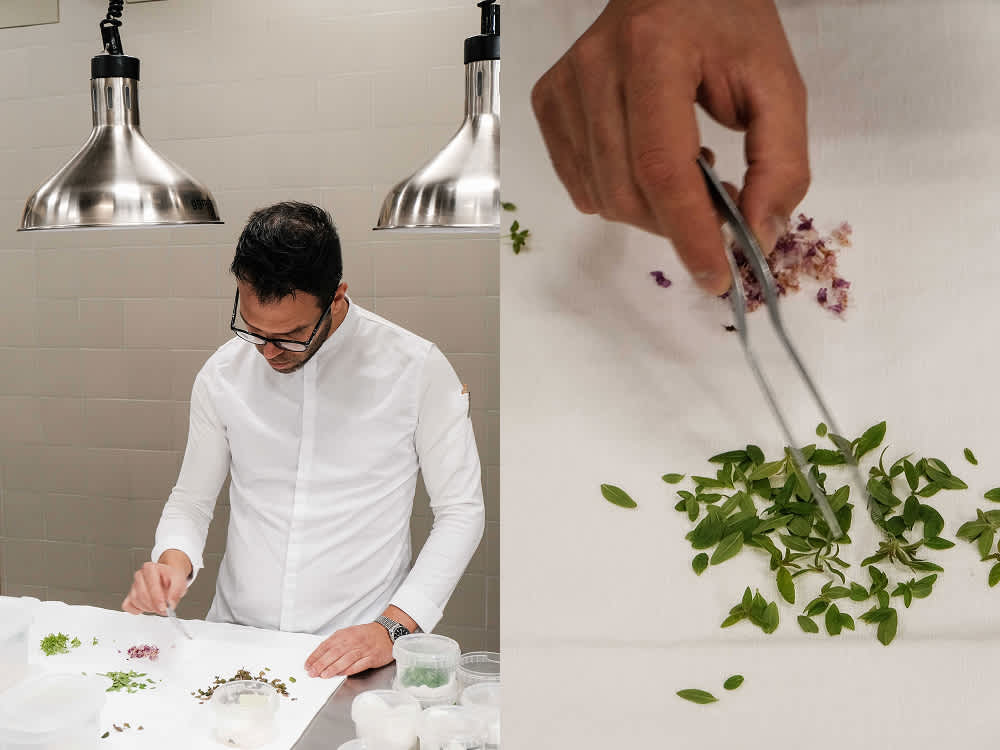Let us introduce you to the world’s most exciting hotel chefs as we guide you through the gourmet getaway spots we’re hungering for…
WHO’S IN THE KITCHEN?

If we’d grown up in Tuscany’s fertile fields, we’d be as obsessive about food as Riccardo Bacciottini. Hailing from ancient settlement Poggibonsi, the chef drew on the region’s rich culinary heritage and bountiful produce — plus his nonna’s hand-me-down recipes — to hone his cooking style. Like Ceasar donning some Brunello Cucinelli cashmere, Bacciottini’s menus at Monteverdi’s Oreade restaurant refresh traditional flavours in an exciting and modern way.
WHAT’S COOKING?
Storytelling is core to Bacciottini’s cuisine, and his dishes are a poetic translation of evocative childhood memories. Oreade is his mythology-themed orator with tale-telling tasting menus, while Zita (Monteverdi’s more casual eatery) has a more rustic dialect, offering just-so Italian simplicity: think spinach and ricotta ravioli, stuffed zucchini flowers, cantucci and vinsanto.
RECIPE FOR SUCCESS

A chef who’s ascended through some of the most challenging kitchens, Bacciottini earnt his chef whites in Paris, flew to London to work at Gordon Ramsay’s Maze, then progressed to Noma in Copenhagen — each an experience that fed his love of innovation. Working at Monteverdi was a joyous homecoming, where he forages and grows produce on-site; connecting guests to the land he loves through the food he’s so passionate about.
Creatives who have drawn inspiration from Monteverdi have included film director Wes Anderson, chef Dominique Crenn and playwright Jeremy O. Harris. What is it about working at Monteverdi that inspires you?
Monteverdi speaks for itself. Every stone holds a story, and that history is my biggest source of inspiration. Our role is to preserve and showcase that beauty, turning it into hospitality through food and experience.
How does the Tuscan landscape shape your culinary philosophy?
I’m in love with our uncontaminated landscape, full of woods and hills. I try to bring its fragrances and sensations directly onto the plate, using the most genuine and authentic local ingredients. It’s a constant dialogue with the land.
What are the most exciting things you’ve discovered about the diverse dining scenes in London, Paris and Copenhagen?
They’re very different cities, but each has a strong culinary identity. In London, I experienced the influence of French fine dining and the discipline that comes with it. I still remember Roka, a Japanese-inspired fusion restaurant that was one of my favourites.
In Paris, I focused on mastering foie gras. I wanted to learn it in its purest [form]. It was a true test of skill. Copenhagen blew me away with its ability to elevate ancestral techniques born out of necessity into a true strength. I loved eating at Barr, [a quayside eatery] known for its schnitzel and other hearty dishes.

How did working at Noma influence your approach to experimentation in cookery?
Noma taught me to think outside the box. There, nothing was ‘impossible’, it was only a matter of figuring out how [to do it]. We tested countless techniques and ingredients. Only a small fraction ever made it onto the menu, but the process was worth it every time. The biggest revelation for me was to never set limits: try everything, taste the unexpected and turn curiosity into creativity.
What was the best advice you received from Gordon Ramsay and René Redzepi?
From Gordon, I learned to question everything; it’s the key to staying sharp and organised. From René, I took a mantra I carry every day: no matter how far we push technique, nothing will ever be more perfect than nature itself. Simplicity always wins.
What initiatives have you put in place to run Monteverdi’s kitchen as sustainably as possible?
We rotate ingredients between outlets to minimise waste, manage recycling with obsessive care and source only from producers who share our ethical values. On top of that, our Research and Development team gives new life to scraps that would otherwise be thrown away. Nothing truly goes to waste.
How important is weaving a narrative to you when creating a new dish?
It’s not just important — it’s essential. Every dish should deliver emotion, and when it also carries a piece of [your] story, it becomes culture. A great example is our ‘Apple’ dish, inspired by the Francesca apple, celebrated by the Medici family and immortalised in a painting by Bartolomeo Bimbi. It’s deeply personal to me, because my grandparents used to tell me how these apples were once used to perfume wardrobes. That memory lives in the dish.

You source many ingredients through foraging — what have been some of your most exciting or rare finds?
During a walk into the woods with some expert foragers, we studied different types of ferns. The biggest surprise? Realising that the roots of certain ferns carry flavours of liquorice. It was pure wonder.
Which one ingredient could you not live without?
Apple-cider vinegar and shallots. I love the sharpness of vinegar paired with the delicate sweetness of shallots. For me, they’re essential ingredients.
Monteverdi’s history stretches back to mediaeval times — have you revived any historic Tuscan dishes or reinterpreted any techniques?
Yes — at our restaurant Zita, we paid homage to the Etruscans with [a dish called] ‘Brustico’: perch cooked over wet reeds set on fire. It’s an ancient technique that gives the fish an intense smokiness and a unique crunch. For me, it’s a bridge between past and present.
What have been your most rewarding interactions with guests at Monteverdi’s culinary events and cookery classes?
When guests truly connect with our philosophy, the conversation shifts, it’s no longer just about food. We start talking about art, history and authenticity. Those are the moments I treasure the most. We want to leave the core values of Monteverdi’s vision imprinted in the memory of our guests.
Where do you go in Monteverdi to relax during your downtime?
In our garden. We plan the planting of new herbs and flowers, and often I wander through them, smelling, tasting and imagining new pairings.

How do you envision the next chapter of Monteverdi’s culinary story?
Self-sufficiency — growing fruits and vegetables, producing products and cured items, and even raising livestock fed with forage we grow ourselves. That’s my vision for Monteverdi.
If you weren’t cooking in Tuscany, where else in the world could you imagine creating a restaurant and why?
I’d go back to Mexico, specifically Tulum. I once joined a pop-up there with Noma, and it was magical. Cooking in the forest with only open fire made me feel what I always try to transmit through my cuisine: a return to origins, to simplicity, to the essence of food.
ANSWERS À LA MINUTE

You’ve been tasked with creating an in-flight menu. What’s on there?
Probably lamb belly in a ‘Porchetta’ style’.
You’ve snuck some minis onto the plane. What cocktail are you making?
Whiskey Sour.
What’s the first thing you do when you arrive at a hotel?
Checking the bathroom — it has to be spotless.
Room service: what are you ordering?
Club sandwich.
Which dish instantly transports you home?
Florentine steak cooked over charcoal.
Which dish from your travels do you wish you’d created?
The calamari with egg and white truffle at three-Michelin-star-holding restaurant Lasarte in Barcelona.
What’s your guilty-pleasure holiday treat?
A massive raw-fish platter.
Favourite restaurant for blowing the budget?
Casa Tua in Siena, owned by my friend Emanuele Santoro. [It has] amazing seafood and a wine list that’s practically endless.
TIME TO SERVE
Mushroom-stuffed hare in a brandy, port and chocolate glaze
‘Once upon a time, the hare was much more than just game: it was a symbol of freedom, courage and connection to the land. To catch one was an honour, and to turn it into a meal was a ritual. It brings me back to childhood, and I remember that when my grandmother cooked this “trophy”, it was truly an unmissable event.
‘Unfortunately, we are now losing both the ability to handle this prized animal and the willingness to work with it; so this dish is a tribute to all the grandmothers who, with love and patience, dedicated themselves to preparing this historic delicacy so we don’t forget where we come from.’
How to make Riccardo’s grandmother’s game dish…
Ingredients
– One whole hare
For the filling:
– 5g preserved truffle
– 7g truffle oil
– 31g hare mousseline
– 140g pork mousseline
– 27g diced hare tenderloin and loin meat
– 70g ground pork
– 60g sautéed mushrooms
– 10g brandy reduction
– 2g pickled shallot
– chopped sage and rosemary, plus salt and pepper, to taste
For the wine reduction:
– 1kg red onions
– 1kg celery
– 1kg carrots
– 20g dried green pepper
– 20g smoked Sarawak pepper
– 10 bay leaves
– 1 garlic bulb
– 8 litres of red wine
For the glaze:
– 200g hare stock
– 50g brandy reduction
– 50g port reduction
– 30g Amedei 90% dark chocolate
First, prep the filling by mixing all the ingredients together, season with salt and pepper, and place in a piping bag.
Then, to make the wine reduction, sweat all the vegetables together in a pan with some oil and season with salt, before adding the two types of pepper and bay leaves. Toast for a few minutes, then pour the wine over the mixture to deglaze. Cook until the alcohol has evaporated, then let the reduction cool with the vegetables inside.
Next you’ll need to debone the hare. Take the two lateral parts and pound with a meat mallet until they’re a uniform thickness. Marinate the meat overnight in some of the brandy reduction. The next day, dry the pieces and use the piping bag to add the filling. Roll and tie — not too tightly — and wrap in cheesecloth. Vacuum-seal the prepared loins along with the red-wine reduction and cook for 12 hours at 62°C.
Gently melt the chocolate in a bowl over a low heat. Add to the other glaze ingredients and stir until the mixture has a smooth consistency. Then, using a pastry brush, glaze the cooked hare and serve.
Hungry for more? Discover more of the destination-dining heroes in our Yes, Chef series



